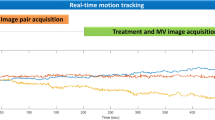Background and Purpose:
For accurate positioning of the prostate in external radiotherapy, transabdominal ultrasound localization and positioning systems are available. Reports have stated that probe pressure applied during image acquisition causes clinically relevant prostate displacement. The aim of this study was to investigate the prostate displacement due to the pressure applied during transabdominal ultrasound image acquisition with the BAT® ultrasound system.
Material and Methods:
For ten patients who had undergone iodine-125 seed implantation for brachytherapy of prostate cancer, X-ray simulations were performed before and during ultrasound image acquisition. The iodine seeds are visible on the X-ray images, representing the position of the prostate. The simulator’s crosshair, indicating the isocenter, was used as reference coordinate system. For each patient the change in prostate position was calculated based on the seed positions during and after ultrasound examination.
Results:
A maximum displacement of the prostate of 2.3 mm in anteroposterior and 1.9 mm in craniocaudal direction and a rotational change of up to 2.5° were observed. If the system was not handled correctly and too much pressure was applied, a shift of the prostate of up to 10 mm could be induced.
Conclusion:
Compared to the prostate displacement due to changes in rectal filling, which according to Crook et al. can be as much as 1.7 cm, the maximum displacement of less than 0.3 cm caused by the probe pressure is negligible. However, proper education of the staff and preparation of the patient are essential for the safe use of the system.
Hintergrund und Ziel:
Zur genauen Positionierung der Prostata in der Teletherapie stehen Ultraschall-Lokalisationssysteme zur Verfügung. Ziel der Studie war zu untersuchen, ob der Druck, der während der BAT®-Ultraschallaufnahme ausgeübt wird, eine klinisch relevante Verschiebung der Prostata bewirkt, die den Nutzen eines solchen Systems für die Patientenpositionierung in Frage stellt.
Material und Methodik:
Von zehn Patienten mit Iod-125-Seed-Implantaten wurden während und nach der Ultraschallaufnahme Röntgensimulationsaufnahmen angefertigt. Die in den Röntgenaufnahmen sichtbaren Seeds repräsentieren die Lage der Prostata. Das Fadenkreuz des Simulators wurde als Referenzkoordinatensystem verwendet. Für jeden Patienten wurde die Lageänderung der Prostata aus der Änderung der Seedpositionen bestimmt.
Ergebnisse:
Bei korrekter Anwendung des Ultraschallsystems wurde die Prostata maximal bis zu 2,3 mm in anteroposteriorer und 1,9 mm in kraniokaudaler Richtung verschoben und um maximal 2.5° rotiert. Durch falsche Handhabung des Systems mit zu hohem Druck konnte eine Verschiebung der Prostata um bis zu 10 mm bewirkt werden.
Schlussfolgerung:
Im Vergleich zu der natürlichen Lagevariation der Prostata durch unterschiedlich starke Rektumfüllung, die nach Crook et al. bis zu 1,7 cm betragen kann, ist eine maximale Verschiebung von weniger als 0,3 cm durch den Schallkopfdruck vernachlässigbar. Um das Potential des Systems voll zu nutzen, müssen eine korrekte Handhabung und Patientenvorbereitung gewährleistet sein.
Similar content being viewed by others
Author information
Authors and Affiliations
Corresponding author
Rights and permissions
About this article
Cite this article
Dobler, B., Mai, S., Ross, C. et al. Evaluation of Possible Prostate Displacement Induced by Pressure Applied during Transabdominal Ultrasound Image Acquisition. Strahlenther Onkol 182, 240–246 (2006). https://doi.org/10.1007/s00066-006-1513-0
Received:
Revised:
Issue Date:
DOI: https://doi.org/10.1007/s00066-006-1513-0
Key Words:
- Ultrasound localization
- Image-guided radiotherapy
- Prostate motion
- Ultrasound probe pressure
- Patient positioning




